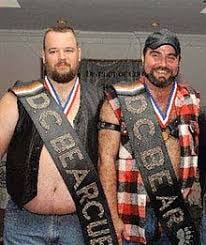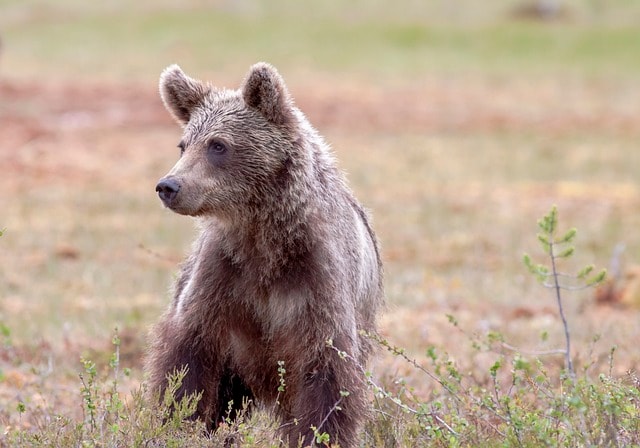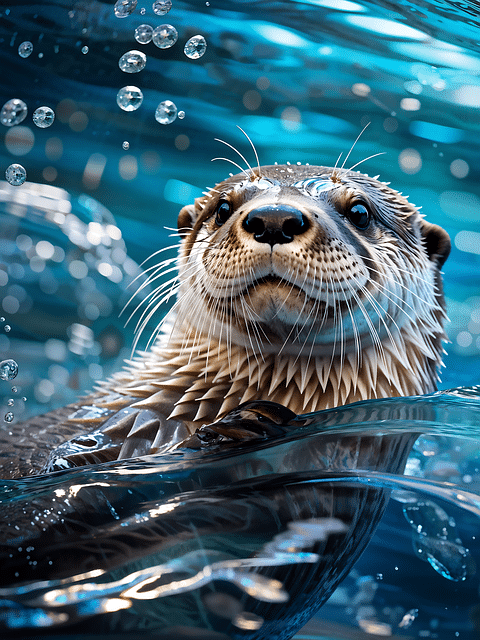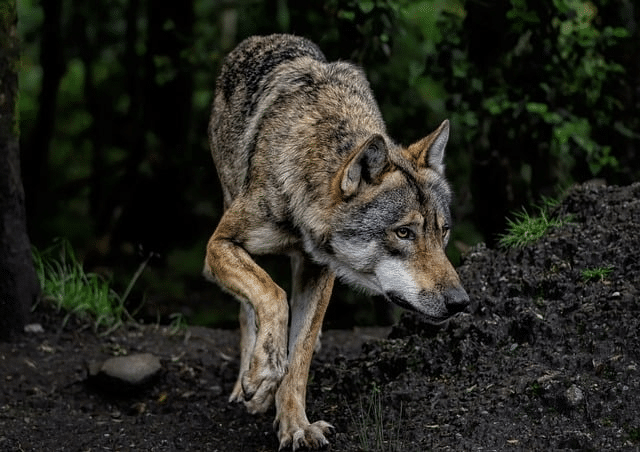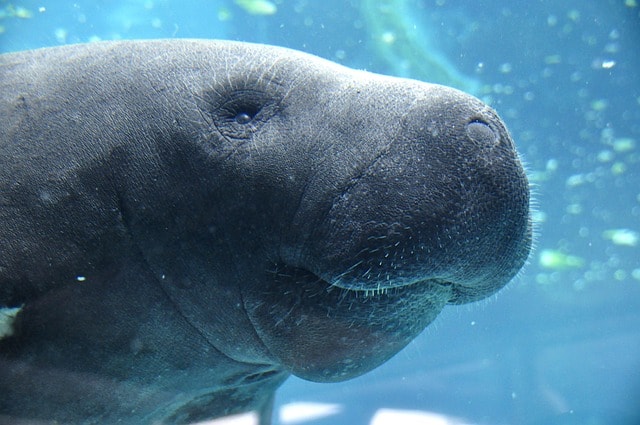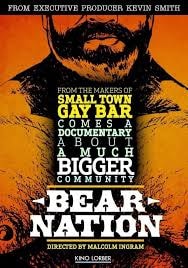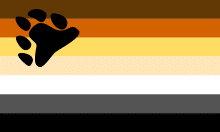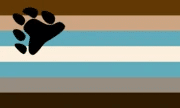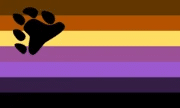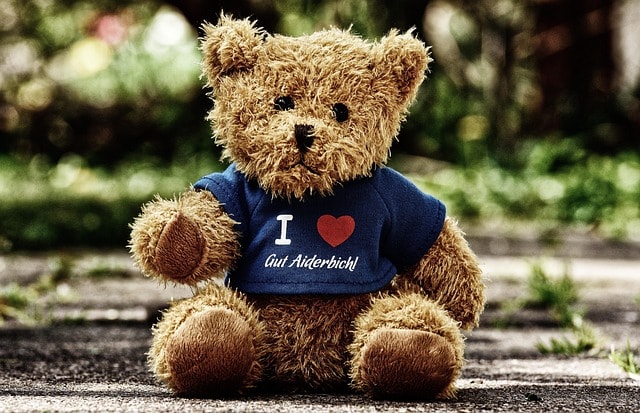Gay Bear: Meaning, Culture and Types
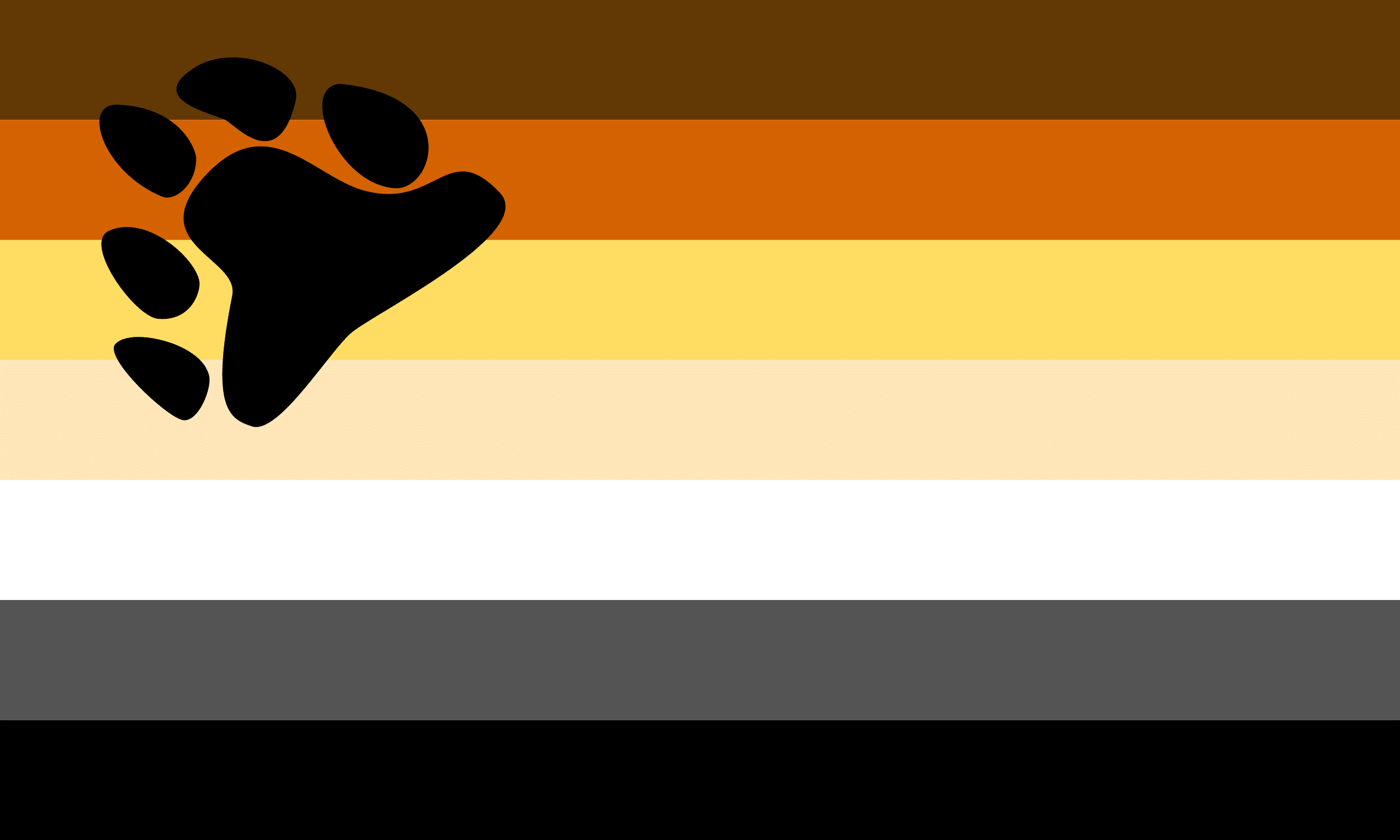 Bear flag
Bear flag
In gay culture, in particular in the gay male subculture, gay bears, more commonly referred to as just a bear, is a larger – and often hairy – bisexual or gay man who is seen to portray or display a form of untamed, rugged, wild masculinity, often with a full beard, chest hair, and a lot of other body hair.
Generically speaking, the term bear is used to describe men who portray the aesthetics of working-class manhood. There is also a strong connotation between bears and the rural LGBT community.
Bear culture is often associated with discovering forms of masculinity, as gay men queer what it means to be masculine through the reputation of being kind, sensitive, and affectionate. As such, the bear subculture has made an important contribution to changing the public perception of the larger gay community, by showing that not all gay men have the same physical appearance – in particular regarding facial and body hair – and that there is no one way of being “mainstream gay.” In doing so, the bear movement has also not only contributed to bear identity and gay male culture but to the masculine gender role in general.
Table of Content
Gay Bear – What is it? What does it mean?
In gay culture, in particular in the gay male subculture, gay bears, more commonly referred to as just a bear, is a larger – and often hairy – bisexual or gay man who is seen to portray or display a form of untamed, rugged, wild masculinity, often with a full beard, chest hair, and a lot of other body hair.
Generically speaking, the bear is a gay term that is used to describe men who portray the aesthetics of working-class manhood. There is also a strong connotation between bears and the rural LGBT community.
Bear culture is often associated with discovering forms of traditional masculinity, with men in the community queering masculinity what it means to be masculine through the reputation of being kind, sensitive, and affectionate. As such, the subculture has made an important contribution to changing the public perception of the larger gay community, by showing that not all queer men have the same physical appearance – in particular regarding facial and body hair – and that there is no one way of being “mainstream gay.” In doing so, the bear movement has also not only contributed to bear identity and gay male culture but to the masculine gender role in general.
Terminology
Different types of bear
The term bear refers to the large, rugged, and hairy men, an aesthetic that has traditionally been associated with bears. As such, the term is derived from masculine secondary sexual characteristics. However, since the term’s inception in the 1970s, the bear community has grown exponentially and has come to include men who are gay in all shapes and sizes, with various terms associated with different types of bear subculture, based on any number of characteristics. Because of this, by now, the bear community constitutes a varied bunch. Below, we outline the main types of bears you can find in the gay community.
Bear Cub
A bear cub is a young man who has a bear physique, but may be smaller or have less bear fur. Bear cubs may also display more traditionally effeminate characteristics, such as a smaller build and less facial hair or body hair, although this is not necessarily the case.
Bear Chub
A bear chub is a bear who is fat, overweight, or obese. Bear chubs sometimes consider themselves separate from the bear community and, instead, a distinct subculture in the gay community.
Muscle bears
An (extremely) fit and muscled bear. Muscle bears are almost always hairy men within the LGBTQ community.
Panda or Panda Bear
A (panda) bear is a bear of (Eastern) Asian descent.
Pocket bear
A short bear.
Polar bear
A polar bear is a – usually older – who has white hair on their head and body.
Baby bears and older bears
Quite self-explanatory, these terms refer to younger and older bears. Baby bear and (bear) cub may be used interchangeably.
Leather bear
A bear who has a leather fetish and/or is into bondage sadomasochism (BDSM).
Trans bear
A transgender bear. Typically a transgender man, although this is not necessary.
Butch Bear
A large, rugged, female bear. Typically they are lesbian or bisexual.
Ursula or lesbear
A female bear. Typically ursulas are lesbian or bisexual female bears, whereas lesbear is only used for female lesbians.
Femme bear
A queer femme bear. A femme bear can be male, female, or anything else, as long as they present themselves in an effeminate way.
Terms related to bears
In addition to the rich variety of bears in the bear community, there are also some terms that are widely recognised as referring to someone who is not a bear but still has a strong connection to bears and bear culture. Here, we explain a few of these terms.
Admirer or Chaser
A term for someone, regardless of gender, who is sexually and/or romantically attracted to bears. Usually not a bear themselves. Also called bear lovers.
Goldilocks
A – usually heterosexual – female who is often spotted accompanied by one or multiple bears. Female version of Gobi.
Gobi
A – usually heterosexual – male who is often spotted accompanied by one or multiple bears. Is not a bear himself. Male version of Goldilocks.
Otter
Otters are hairy and slim or small-framed gays. There is no clear consensus on whether otters are part of the bear culture or should rather be seen as a separate gay subculture.
Wolf
Wolves are gay guys with body and facial hair who, instead of a round belly, have a lean, muscular, and/or athletic build.
Manatee
A large, hairless gay man.
Grrr! and Woof!
These are slang terms relating to flirting within the bear community. These expressions of physical attraction are uttered by one bear to another, usually in public, to indicate interest in each other for dating or sex.
As described above, there are bears of all sorts, shapes and sizes. Long gone are the times that all bears were men who identified as gay, and the bear identity has broadened a lot since the 1970s. With this comes a multitude of different pronouns to be used for different types of bears; good examples of this include the inclusion of butch or femme bears, lesbears, and ursulas into the bear community. It is also not uncommon anymore to see drag queens or a transgender person at bear happenings, either as a trans bear or not.
Each of these groups represent a different form of gender presentation in the bear community, and with that come different pronouns as well. So, be mindful of how bears self identify, as you should not assume that all bears go by he/him pronouns. As always, even when the bear in front of you looks like a big hairy man, it is considerate to ask them for their pronouns and assume nothing.
History
Origins of the bear community
The term bear in (mainstream) gay culture became popular in the 1970s and 1980s and originated in and around San Francisco, California, USA. Originally, all hairy homosexual men, regardless of shape, were considered a bear, until the term was appropriated by larger gay men, with different terms being coined for hairy men with a smaller frame. Later, terms would be coined for hairless gay men of a large build as well, and many other categories followed.
Bear culture began as a form of protest against urban gay culture as it developed in major hotspots such as New York City. In these urban settings, predominately effeminate, often called “camp,” gay men set the tone for how people – both within and outside the gay community – came to see the stereotypical gay man. In contrast to the thoroughly groomed and trimmed body and facial hair of many urban gay men, bears portrayed a more raw and rugged version of homosexuality and gay masculinity. This went hand in hand with the romanticisation of life in rural areas, including the sexualisation of traditionally masculine, rural professions, such as cowboys and lumberjacks.
Bears meeting bears
In the 1970s 1980s, bear communities would arrange events for bears to meet. These bear events gained very quickly in popularity due to the rapid emergence of the Internet, which allowed small communities to form in relative privacy and enabled bears to find each other. Events in the San Francisco Bay Area at which bears met were called Bear Hug Parties, such gatherings were named after a euphemism for sex between bears. So, while the bear community was not yet a part of mainstream gay culture, the subculture started gaining visibility and recognition.
Popular ways for bears to meet each other – besides these Bear Hug Parties – were through loosely organised social clubs, called bear clubs. Examples of such bear clubs in San Francisco included leather biker-patch clubs or hobby clubs. These groups often had a strict – though unwritten – set of rules, requirements, and expectations for and from its members. Such rules were often considered necessary to protect members’ privacy, which bears place importance on, and safety. Note that ‘bear club’ did not, originally, refer to nightclubs for bears in the same way gay clubs are popular nowadays.
In the 1980s, such bear parties started organising and collectively funding large, annual meet-up events for bears to meet other bears, share in bear culture together, and celebrate a rudimentary form of bear pride. Such an annual gathering is usually referred to as ‘bear run,’ ‘bear week,’ or ‘bear gathering.’ These events rapidly gained popularity in San Francisco, from where the phenomenon started spreading to other cities and countries across the world. Famous and/or popular examples of such bear runs include Bearstock, HiBearNation, Bear Pride, and Bear Bash.
Various Forms of Bear Media And Lit.
One important factor in why the bear community rose to mainstream gay culture – and even became a mainstream sub-culture in society – is the extensive writing that has been done on this subject. For one, the term ‘bear’ itself was popularised by author Richard Bulger who, with his partner at the time Chris Nelson, founded Bear Magazine in 1987. They built off of the already rising popularity of the term after being used in a printed and published academic article in 1982 by Les K. Wright: Sociology of the Urban Gay Bear. The article, edited by Jack Fritscher, was published in Drummer magazine. Fritscher also founded the San Francisco California Action Guide, which became the first magazine to publish the term bear, with the gay culture meaning, on its cover, also in 1982.
Before Bear Magazine, Drummer magazine, or the San Francisco California Action Guide played its part in popularising the term, however, another author, George Mazzei wrote a famous article named “Who’s Who in the Zoo.” This article, published by The Advocate in 1979, described seven “types” of gay men, each named after an animal, of which bear was one. This is the first recorded instance of a magazine using the term bear in this context. For this reason, The Advocate claims the credit for coining this term, although it is hard to verify this.
In 1995, some 13 years after writing Sociology of the Urban Gay Bear, Les Wright also founded the Bear History Project, an initiative to collect, document, and preserve bear history. Thanks to Wright’s efforts, iconic pieces of literature such as The Bear Book by John Dececco (1999) and The Bear Book II (2001) could be published, which eventually led to the US Library of Congress recognising “bear” as its own category.
In 2000, Ray Kampf wrote The Bear Handbook: A Comprehensive Guide for Those Who Are Husky, Hairy and Homosexual, and Those Who Love ‘Em, which is seen by many bears as a very influential piece of media for bear culture.
Bears in pop culture
From the late 1980s and early 1990s onwards, bear culture spread rapidly, inspiring hundreds of thousands across the world. Fritscher played an important role in this as he, together with producer Mark Hemry, co-founded Palm Drive Video in 1984, which produced “homomasculine entertainment.” Over his career, Fritscher wrote, cast, and directed more than 150 features, significantly influence bear culture.
In the 1990s, so-called ‘bear contests’ took a flight in popularity, being organised across the States and the world. These bear contests, which took place at many different bear events, are a sort of bear beauty pageant where winners could be awarded a local title. In 1992, the International Bear Rendezvous in San Francisco organised its first-ever International Mr. Bear contest, during which contestants from all over the world, usually local title-holders, competed against each other in a bear contest. The International Mr. Bear contest took place each February from 1992 until 2011, when it was discontinued. In the meantime, however, many others took its place, with bears celebrating different forms of bear pride or bear week all over the world, from Amsterdam to Mexico City. Keep in mind that such events aren’t just fun. When members of the LGBTQ community connect they may have fewer mental health issues.
Famous or iconic figures in the bear community include Jack Radcliffe and Catalina Video, who are responsible for producing products and accessories closely related to the bear community or featuring bear icons. There is also a rich market for adult movies, with popular adult studios that feature bears or bear-type men are Titan Media, Bear’s Life magazine, Bear Magazine, Bear Bones Books, Butch Bear, BearFilms, Bear, and Raging Stallion. There was also a documentary, Bear Nation, produced in 2010 that explored the lives of folks within the bear community.
Bear culture is nowadays widely endorsed by mainstream popular culture, with reference to the bear community having been made at various occasions in the American hit series The Simpsons and Pixar’s 2015 blockbuster Inside Out, among many others.
Unfortunately, there is no international bear awareness day. There is, on March 23rd, a so-called World Bear Day, which some interpret as Gay Bear Awareness Day, but this is actually a celebration dedicated to the rescue and protection of bears, the animals, around the world.
Flags And Symbols
The international bear brotherhood flag consists of seven, horizontal differently coloured strokes of equal breadth. From top to bottom, the bear flag shows a collection of different shades of brown and gold, coupled with white, grey, and black. These colours were specifically chosen for the flag as the different shades of brown and gold represent the different species of bears. As such, the international bear brotherhood flag represents and celebrates the diversity in the bear community. This pride flag was created by Craig Byrnes in 1995.
In the top left corner of the flag, a bear paw print can be seen. This paw print, naturally, is a nod to all bears, and can be found on other variations of the flag as well. While not officially a symbol, its prominent presence on the flag makes the bear paw a well-recognised symbol in the bear community.
Bear flag
Transgender bear flag
The non-binary bear flag
Am I a Bear?
After reading about such a fascinating community, you may wonder: “Am I a bear?” Perhaps this question is easy for you to answer if you are a big, bulky, gay hairy man. If not but you still want to be a bear, or feel like you are a bear: well, you’re in luck because, as it so happens, physical stature has not been the determining factor in the bear concept for a long time! Who is and isn’t a bear is the topic of an ongoing debate but the fact is that, if you want to join a bear community, you will most likely be able to find and join one in most places with prominent gay population all over the world.
So how do I figure out if I am a bear? Well, the most important part is that you feel that you want to be part of the bear community. Great ways to figure this out is by learning about the bear movement, joining or visiting bear organizations, celebrating bear pride, and going to bear runs. Keep in mind that figuring your bear identity is a personal journey to self acceptance and there is no right or wrong way to do it. Some people may want to read Bear Book, Bear Book II, or the Bear Handbook to educate themselves on the origins and struggles of the bear community (there is a list of further readings included in this article). Others look to bears as champions of a particular type of gender expression and are more interested in this aspect of the this subculture.
However you go about discovering your own bear identity, do so in a way that is considerate of and respectful towards the bears in your surroundings and to the bear community as a whole; joining the subculture can be a beautiful thing as long as you do so keeping in mind that the bear community is a safe haven for many, so don’t go to bear clubs like those endorsed by bear World Magazine seeking only entertainment! And last but not least, keep in mind that you can be a bear lover without being a bear yourself; just think of gobis or a goldilocks!
How to Support a Member of The Bear Community
Supporting a bear friend
If you have a friend or acquaintance who is a bear, there are several things you can do to support them. The most important thing, as always, is to listen, offer support, and respect their wishes; since the bear subculture has become such a large part of mainstream pop-culture, many bears feel they do not need or want any particular support, whereas others are happy with all the help they can get. This obviously depends on the person and their personality, but may also depend on where you live, as this affects the acceptance of the LGBT community or the bear community in your area.
General ways you can support bears in your area include supporting bear clubs, LGBT advocacy groups, and gay pride or bear pride. During bear pride, you may also show your support by waving the international bear brotherhood flag to show that you are an ally. You can also support the organisation of a bear event organised by bears, bear clubs, or bear lovers, held in many major cities across the world, including New Orleans.
Finally, as is extensively described above, there are many types of bears. Keep in mind that the problems encountered by a butch or trans bear are very different, which is why you should always offer support based on the person’s needs and wants, instead of assuming what to do. You should also be sure the person choose to self identify in this way. Some may take offense at assumptions or comments about their body. Also some folks object to being categorized by body types. That said, if they embrace it, compliment them on the features they are proud of like their rugged masculinity.
Dating a bear
If you are dating a bear, there are a few things to keep in mind. Firstly, of course, keep in mind that no two bears are the same, and maintain open communications with your bear so that both of you know what the other person likes and dislikes. Never assume preferred sexual roles. In addition, as mentioned above, keep in mind the possible particularities that arise when dating a particular sub-type of bear, such as a femme bear, who may have different dating preferences than your typical wolf or bear chub.
Further Readings
Bear must-reads
“The Bear Handbook: A Comprehensive Guide for Those Who Are Husky, Hairy and Homosexual, and Those Who Love ‘Em” by Ray Kampf (2000), Haworth Press. ISBN 1-56023-996-4
“The Bear Book: Readings in the History and Evolution of a Gay Male Subculture” by Les K. Wright (1997), Haworth Press. ISBN 1-56023-890-9
The Bear Book II: Further Readings in the History and Evolution of a Gay Male Subculture” by Les K. Wright (2000), Haworth. ISBN 978-0-7890-0636-3
“Bears on Bears: Interviews & Discussions (Revised Edition)” by Ron Jackson Suresha (2009), Lethe Press.
More on coming out as a bear
“Coming to Terms” by Ron Jackson Suresha, in Bi Men: Coming Out Every Which Way, edited by Pete Chvany (2005), Routledge.
More on Lesbears and Transbears
“Lesbears and Transbears: Dykes and FTMs as Bears” in “Bears on Bears: Interviews & Discussions (Revised Edition)” by Ron Jackson Suresha, Lethe Press.
More on ursulas and being a queer and/or femme bear
“Beary feminine: Lesbians are claiming an identity gay men monopolize” by Tanya Gulliver (2002), Xtra.
“A woman in the bear community” by Iz Connell (2018), Archer.
Bears and Race
“Ethnic Bears and Bears of Color” in Bears on Bears, Suresha.
Bears and gender
“Bear Bodies, Bear Masculinity: Recuperation, Resistance, or Retreat?” by Peter Hennen (2005), Gender and Society.
Resources
https://glreview.org/article/bear-culture-101-no-prerequisite/
https://www.pride.com/identities/gay-animal-types
https://www.imdb.com/title/tt1545021/
https://www.bearwww.com/blog/understanding-gay-bear-culture-definitions-significance/
https://leskwright.com/bear-history-project/
Share this post:
What do you think?
 Bear flag
Bear flag


